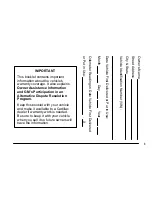
Snow Tires
Some areas of the country require the use of snow tires
during the winter. Snow tires can be identified by a
“mountain/snowflake” symbol on the tire sidewall.
If you need snow tires, select tires
equivalent in size and type to the origi-
nal equipment tires. Use snow tires
only in sets of four; failure to do so
may adversely affect the safety and
handling of your vehicle.
Snow tires generally have lower speed ratings than what
was originally equipped with your vehicle and should
not be operated at sustained speeds over 75 mph
(120 km/h). For speeds above 75 mph (120 km/h) refer to
original equipment or an authorized tire dealer for
recommended safe operating speeds, loading and cold
tire inflation pressures.
While studded tires improve performance on ice, skid
and traction capability on wet or dry surfaces may be
poorer than that of non-studded tires. Some states pro-
hibit studded tires; therefore, local laws should be
checked before using these tire types.
Tire Spinning
When stuck in mud, sand, snow, or ice conditions, do not
spin your vehicle’s wheels above 30 mph (48 km/h) or
for longer than 30 seconds continuously without stop-
ping.
Refer to “Freeing A Stuck Vehicle” in “What To Do In
Emergencies” for further information.
5
STARTING AND OPERATING
417
Summary of Contents for Challenger SRT 392
Page 4: ......
Page 7: ...1 INTRODUCTION 5...
Page 10: ......
Page 98: ......
Page 186: ...Slow Tone Solid Arc Fast Tone Flashing Arc 184 UNDERSTANDING THE FEATURES OF YOUR VEHICLE...
Page 216: ......
Page 340: ......
Page 413: ...5 STARTING AND OPERATING 411...
Page 534: ......
Page 535: ...MAINTENANCE SCHEDULES CONTENTS MAINTENANCE SCHEDULE 534 Maintenance Chart 536 8...
Page 546: ......
Page 557: ...INDEX 10...
















































